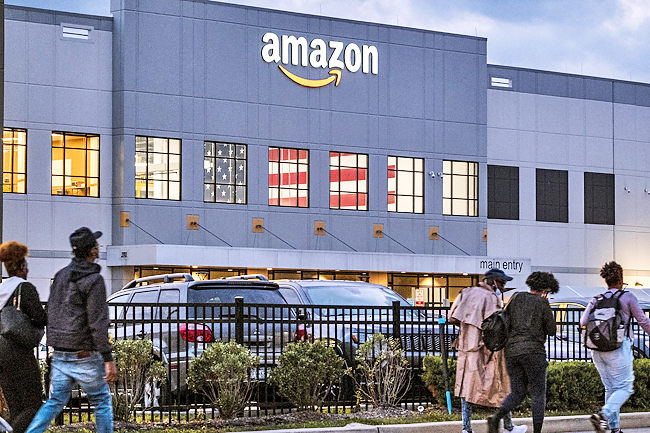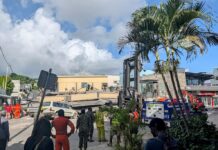AP – Amazon is gearing up for its toughest labour fight yet, with two separate union elections coming to a head as soon as next week that could provide further momentum to the recent wave of organising efforts across the country.
Warehouse workers in Staten Island, New York, and Bessemer, Alabama, will determine whether or not they want to form a union. If a majority votes yes at either location, it would mark the first successful United States (US) organising effort in Amazon history. Rejection would notch another victory for the country’s second-largest employer in keeping unions at bay.
Here’s what the elections will look like in Bessemer and Staten Island:
THE VOTING
Last April, workers in Bessemer overwhelmingly voted against a union bid, providing a bitter defeat for a labour movement that had already been declining in influence but making some gains during the pandemic. Federal labour officials later scrapped the results and ordered a re-do, ruling Amazon tainted the election process.
Ballots for the second election were mailed to 6,100 employees in early February. The counting process is expected to start today and could last for several days.
Meanwhile, Amazon workers in the Staten Island warehouse began in-person voting last Friday in their first union election. The facility is one of Amazon’s largest in New York City with more than 8,300 employees. Voting will wrap up on Wednesday, with the counting expected to begin shortly thereafter.

UNION SUPPORT
The Retail, Wholesale and Department Store Union (RWDSU) is once again spearheading the drive at the Alabama facility. Over 150 organisers from the union, as well as from roughly 20 other labour groups were on the ground since last summer – a bigger push than in the first election – to galvanise support. Vaccines made it easier during the ongoing pandemic to knock on workers’ doors and also visit barbershops, stores and other places to distribute flyers and chat with residents.
Pulling off a win could still be tough. There’s high turnover at the facility, making it difficult to build momentum. At the same time, organisers estimate about half of current workers were eligible to vote in the last election, offering the RWDSU a chance to tap new workers who may be more amenable to a union.
In Staten Island, Amazon workers are currently organising under the independent Amazon Labour Union led by Chris Smalls, a former employee who said he was fired after leading a protest over the warehouse’s working conditions in the early days of the pandemic.
The nascent union seeks to negotiate higher wages, more paid time off and other benefits for workers, 100 of which sit on its worker committee. Some of them have been wearing shirts and masks with the group’s logo during work shifts. Others have been handing out pro-union flyers after work and encouraging their co-workers to unionise.
NEW YORK VS ALABAMA
The union landscape in Alabama is starkly different from New York.
Last year, union members accounted for 22.2 per cent of wage and salary workers in New York, ranked only behind Hawaii, according to the Bureau of Labour Statistics. That’s more than double the national average of 10.3 per cent. In Alabama, it’s 5.9 per cent.
Alabama is also a right-to-work state, which prohibit a company and a union from signing a contract that requires workers to pay dues to the union that represents them. Pro-labour experts said many may feel intimidated by companies that could undermine the unionised shop.
New York is not a right-to-work state, and Amazon is attempting to use that to its advantage. The company is telling workers it could fire them should they unionise but fail to pay union dues. But that requirement is not an across-the board mandate for non-right-to-work states and is something that is negotiated during union contracts, said senior state policy coordinator at the left-leaning Economic Policy Institute Jennifer Sherer.
THE WORKERS
The mostly Black workforce at the Alabama facility, which opened in 2020, mirrors the Bessemer population of over 70 per cent Black residents, according to the latest US Census data. There’s little public transportation, so many of the Amazon workers drive to the facility from as far away as metro Montgomery, nearly 100 miles to the south.
Pro-union workers said they want better working conditions, longer breaks and higher wages. Regular full-time employees at the Bessemer facility earn at least USD15.80 an hour, higher than the estimated USD14.55 per hour on average in the city. That figure is based on an analysis of the US Census Bureau’s annual median household income for Bessemer of USD30,284, which could include more than one worker.
At Amazon’s Staten Island facility, which opened in 2018, workers earn a minimum hourly wage just over USD18, much lower than the estimated USD41 per hour average for the borough, according to a similar US Census Bureau analysis of Staten Island’s USD85,381 median household income.
Workers from across the New York metro area trek long distances to get to the company’s warehouse, many times alternating between the subway, a ferry and 40-minute long public bus rides.
The ALU said it doesn’t have a demographic breakdown of the warehouse workers in Staten Island and Amazon declined to provide the information to The Associated Press, citing the union vote. But internal records leaked to The New York Times from 2019 showed more than 60 per cent of the hourly associates at the facility were Black or Latino, while most of managers were white or Asian.
AMAZON’S STRATEGY
Amazon sees unions as a threat to its business model built on speedy deliveries to customers.
“As a company, we don’t think unions are the best answer for our employees,” an Amazon spokesperson said in a e-mailed statement. “Our focus remains on working directly with our team to continue making Amazon a great place to work.”
The online retail giant continues to hammer the message that it offers benefits such as healthcare, 401(k) plans and a prepaid college tuition programme to help grow workers’ careers. It launched a website for workers at both warehouses that casts doubt on the benefit of unions and has been blasting out mailings, text messages, e-mails and flyers.
It also relied on consultants and managers to hold mandatory staff meetings to talk about why unions are a bad idea. Such meetings stopped in Bessemer, right before the ballots were sent on February 4, in accordance with labour regulations. But it could continue in Staten Island until 24 hours before the in-person vote was scheduled to begin on Friday.
A company spokesperson said the meetings give employees the opportunity to ask questions and learn what a union “could mean for them and their day-to-day life working at Amazon”.
In Bessemer, Amazon made some changes to but still kept a controversial US Postal Service mailbox that was key in the NLRB’s decision to invalidate last year’s vote. In February, police arrested Smalls after Amazon officials said he was trespassing while delivering food to workers in Staten Island. Two other current pro-union employees were arrested with him for obstructing governmental administration charges.



















































